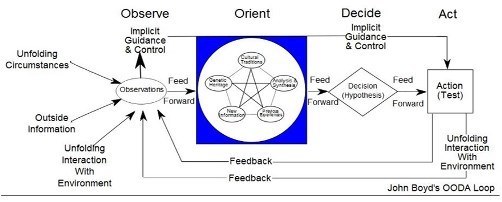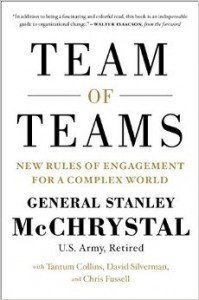I just recently read the book Team of Teams: New Rules of Engagement for a Complex World by General Stanley McChrystal that described the transition of the command and control style of management to the more adaptive approach that I have found successful in working with teams. Though I read the Kindle version, the book flowed well enough that it would be an enjoyable audio book.
Not only the scale of the fight was new; the tools were as well. The development of new information technologies, precision weapons, GPS, night vision, and other advances were also changing how we fought. Descending from blacked-out helicopters that could locate a specific rooftop in a sea of buildings with pinpoint accuracy, operators communicated via headsets with pilots controlling unmanned aerial vehicles that provided constant video surveillance, and, after capturing their target, employed biometric data collection to confirm his identify.
The process that drove our operations in Iraq was a sequence that became known as F3EA: Find—Fix—Finish—Exploit—Analyze. It was simple in concept, and much of it was as old as warfare itself. First, the target needed to he found; then its position would need to be fixed so that we could know where it was in real time: the operators would then finish the target, removing the threat from the battlefield: next, the target would be exploited for any intelligence (a house might be searched, a person interrogated): and finally, intelligence would be analyzed. Then the cycle would begin again. It derived from similar targeting and decision-making processes (like the well-known OODA loop: Observe—Orient—Decide —Assess that became associated with fighter pilots) that sought to increase the effectiveness of operations by continually refining understanding of the situation.
At first we had to adjust to the speed and scale of this fight. We had traditionally functioned in a slower rhythm, conducting occasional, exquisitely planned, surgical strikes, but now we were conducting operations nearly every day, often doing multiple raids simultaneously. We quickly came up to speed. This type of work was not fundamentally new —just the same old thinking at a larger magnitude. Within a few months, we had built our “awesome machine.”
The “awesome machine” that was built makes for the interesting read. And as you will find if you read the book, it is not only about adaptability but the way it was integrated and managed by the leadership team. A great lesson to be learned.
 I have been using the basic structure of the OODA Loop for several years now and have include a download of it from Chapter 5 in CAP-Do: Lean and the OODA Loop. Feel free to distribute the material, just cite the source if you would please.
I have been using the basic structure of the OODA Loop for several years now and have include a download of it from Chapter 5 in CAP-Do: Lean and the OODA Loop. Feel free to distribute the material, just cite the source if you would please.
Lean Sales and Marketing: Learn about using CAP-Do

